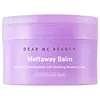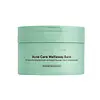What's inside
What's inside
 Key Ingredients
Key Ingredients

 Benefits
Benefits

 Concerns
Concerns

 Ingredients Side-by-side
Ingredients Side-by-side

Ethylhexyl Palmitate
EmollientTridecyl Isononanoate
EmollientCetyl Ethylhexanoate
EmollientPEG-12 Diisostearate
EmulsifyingPolyethylene
AbrasivePEG-20 Glyceryl Triisostearate
EmollientWater
Skin ConditioningPhenoxyethanol
PreservativeVaccinium Angustifolium Fruit Extract
Skin ProtectingTocopheryl Acetate
AntioxidantButylene Glycol
HumectantCaprylyl Glycol
EmollientParfum
MaskingScutellaria Baicalensis Root Extract
AstringentSophora Angustifolia Root Extract
Skin ConditioningGlycyrrhiza Inflata Root Extract
Skin ConditioningSodium Hyaluronate
HumectantCI 17200
Cosmetic ColorantCI 42090
Cosmetic ColorantEthylhexyl Palmitate, Tridecyl Isononanoate, Cetyl Ethylhexanoate, PEG-12 Diisostearate, Polyethylene, PEG-20 Glyceryl Triisostearate, Water, Phenoxyethanol, Vaccinium Angustifolium Fruit Extract, Tocopheryl Acetate, Butylene Glycol, Caprylyl Glycol, Parfum, Scutellaria Baicalensis Root Extract, Sophora Angustifolia Root Extract, Glycyrrhiza Inflata Root Extract, Sodium Hyaluronate, CI 17200, CI 42090
Ethylhexyl Palmitate
EmollientCaprylic/Capric Triglyceride
MaskingPEG-20 Glyceryl Triisostearate
EmollientCetyl Ethylhexanoate
EmollientPEG-12 Diisostearate
EmulsifyingPolyethylene
AbrasivePhenoxyethanol
PreservativeWater
Skin ConditioningCaprylyl Glycol
EmollientGlucosylrutin
AntioxidantCharcoal Extract
Skin ConditioningLactic Acid
BufferingMandelic Acid
AntimicrobialMalic Acid
BufferingLactobionic Acid
BufferingGlycolic Acid
BufferingCapryloyl Salicylic Acid
ExfoliatingSalicylic Acid
MaskingParfum
MaskingTocopherol
AntioxidantCentella Asiatica Extract
CleansingSalix Alba Bark Extract
AstringentBixa Orellana Seed Extract
MaskingSodium Hyaluronate
HumectantEthylhexyl Palmitate, Caprylic/Capric Triglyceride, PEG-20 Glyceryl Triisostearate, Cetyl Ethylhexanoate, PEG-12 Diisostearate, Polyethylene, Phenoxyethanol, Water, Caprylyl Glycol, Glucosylrutin, Charcoal Extract, Lactic Acid, Mandelic Acid, Malic Acid, Lactobionic Acid, Glycolic Acid, Capryloyl Salicylic Acid, Salicylic Acid, Parfum, Tocopherol, Centella Asiatica Extract, Salix Alba Bark Extract, Bixa Orellana Seed Extract, Sodium Hyaluronate
Ingredients Explained
These ingredients are found in both products.
Ingredients higher up in an ingredient list are typically present in a larger amount.
Caprylyl Glycol is a humectant and emollient, meaning it attracts and preserves moisture.
It is a common ingredient in many products, especially those designed to hydrate skin. The primary benefits are retaining moisture, skin softening, and promoting a healthy skin barrier.
Though Caprylyl Glycol is an alcohol derived from fatty acids, it is not the kind that can dry out skin.
This ingredient is also used as a preservative to extend the life of products. It has slight antimicrobial properties.
Learn more about Caprylyl GlycolCetyl Ethylhexanoate is an emollient ester. It comes from cetearyl alcohol and 2-ethylhexanoic acid.
Cetyl Ethylhexanoate is an emollient that adds a velvety feel to skin without being greasy or oily. Emollients help trap moisture into your skin, keeping your skin soft and hydrated.
Ethylhexyl Palmitate, also known as octyl palmitate, is created from 2-ethylhexyl alcohol and palmitic acid. It is a fatty acid ester.
The fatty acid content of Ethylhexyl Palmitate makes it an emollient. Emollients help soften and hydrate your skin by trapping moisture within.
Ethylhexyl Palmitate is also used to help improve the texture of cosmetics. It helps other ingredient dissolve in products and help disperse ingredients more evenly.
You'll likely find this ingredient in sunscreen, as it is often used to mix UV-blocking ingredients such as avobenzone and ethylhexyl triazone.
It can also help stabilize the fragrances in a product as a fragrance fixative.
Ethylhexyl Palmitate can be used to substitute mineral oil.
Due to its high fatty acid content, it may not be fungal-acne safe.
Learn more about Ethylhexyl PalmitateParfum is a catch-all term for an ingredient or more that is used to give a scent to products.
Also called "fragrance", this ingredient can be a blend of hundreds of chemicals or plant oils. This means every product with "fragrance" or "parfum" in the ingredients list is a different mixture.
For instance, Habanolide is a proprietary trade name for a specific aroma chemical. When used as a fragrance ingredient in cosmetics, most aroma chemicals fall under the broad labeling category of “FRAGRANCE” or “PARFUM” according to EU and US regulations.
The term 'parfum' or 'fragrance' is not regulated in many countries. In many cases, it is up to the brand to define this term.
For instance, many brands choose to label themselves as "fragrance-free" because they are not using synthetic fragrances. However, their products may still contain ingredients such as essential oils that are considered a fragrance by INCI standards.
One example is Calendula flower extract. Calendula is an essential oil that still imparts a scent or 'fragrance'.
Depending on the blend, the ingredients in the mixture can cause allergies and sensitivities on the skin. Some ingredients that are known EU allergens include linalool and citronellol.
Parfum can also be used to mask or cover an unpleasant scent.
The bottom line is: not all fragrances/parfum/ingredients are created equally. If you are worried about fragrances, we recommend taking a closer look at an ingredient. And of course, we always recommend speaking with a professional.
Learn more about ParfumPEG-12 Diisostearate isn't fungal acne safe.
Peg-20 Glyceryl Triisostearate comes from Isostearic Acid and glycerin.
It is an emollient, emulsifier, and gentle cleanser. As an emollient, it helps trap moisture to keep skin soft and hydrated. Emulsifiers help prevent ingredients from separating.
This ingredient is common in oil-based products. This is because it helps oil-ingredients be easily washed away without leaving a residue.
Peg-20 Glyceryl Triisostearate may not be fungal-acne safe.
Learn more about PEG-20 Glyceryl TriisostearatePhenoxyethanol is a preservative that has germicide, antimicrobial, and aromatic properties. Studies show that phenoxyethanol can prevent microbial growth. By itself, it has a scent that is similar to that of a rose.
It's often used in formulations along with Caprylyl Glycol to preserve the shelf life of products.
Polyethylene is a synthetic ingredient that helps the skin retain moisture. It is a polymer.
It is also typically used within product formulations to help bind solid ingredients together and thicken oil-based ingredients. When added to balms and emulsions, it helps increase the melting point temperature.
Sodium Hyaluronate is hyaluronic acid's salt form. It is commonly derived from the sodium salt of hyaluronic acid.
Like hyaluronic acid, it is great at holding water and acts as a humectant. This makes it a great skin hydrating ingredient.
Sodium Hyaluronate is naturally occurring in our bodies and is mostly found in eye fluid and joints.
These are some other common types of Hyaluronic Acid:
Learn more about Sodium HyaluronateWater. It's the most common cosmetic ingredient of all. You'll usually see it at the top of ingredient lists, meaning that it makes up the largest part of the product.
So why is it so popular? Water most often acts as a solvent - this means that it helps dissolve other ingredients into the formulation.
You'll also recognize water as that liquid we all need to stay alive. If you see this, drink a glass of water. Stay hydrated!
Learn more about Water